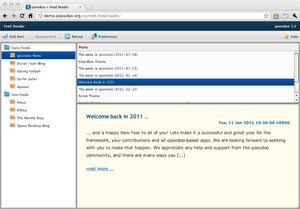qooxdoo
The topic of this article may not meet Wikipedia's notability guidelines for products and services. (May 2020) |
 Web browser running a qooxdoo application | |
| Stable release | 7.2.1
/ July 11, 2022[1] |
|---|---|
| Repository | |
JavaScript application framework | |
| License | LGPL, EPL |
| Website | qooxdoo |
qooxdoo
Framework
qooxdoo is entirely class-based, tries to leverage the features of
GUI toolkit
Despite being a pure JavaScript framework, qooxdoo is quite on par with GUI toolkits like
Defining the user interface needs no
Object-oriented programming
qooxdoo uses a closed form to define new classes. The global class constructor takes two arguments, the name of the new class and a map that provides values for a set of predefined keys, like 'construct' (the constructor method hook), 'statics' (for static class attributes and methods), 'members' (for instance attributes and methods) and 'destruct' (for the destructor). This (possibly large) map represents the class definition. Classes can be derived from other classes using the 'extend' keyword.
The following application skeleton gives an impression of how that works. The code will create a small application with a button that features a tooltip and opens an alert box when pressed. You can also run and edit this code in an online Playground:[4]
qx.Class.define("custom.Application",
{
extend : qx.application.Standalone,
members :
{
main : function()
{
this.base(arguments);
// Create button
var button1 = new qx.ui.form.Button("First Button",
"icon/22/apps/internet-web-browser.png");
// Document is the application root
var doc = this.getRoot();
// Add button to document at fixed coordinates
doc.add(button1, {left: 100, top: 50});
// Attach a tooltip
button1.setToolTip(new qx.ui.tooltip.ToolTip("A nice tooltip",
"icon/32/status/dialog-information.png"));
// Add an event listener
button1.addListener("execute", function(e) {
alert("Hello World!");
});
}
}
});
Ajax
While being a client-side and server-agnostic solution, the qooxdoo project does include optional
See also
- Ajax (programming)
- Comparison of JavaScript frameworks
- JavaScript framework
- JavaScript library
References
- ^ "Release v7.2.1 · qooxdoo/qooxdoo". github.com. 2022-07-11. Retrieved 2022-10-09.
- ^ "qooxdoo Requirements". Retrieved 2 February 2011.
- ^ "qooxdoo Download page". Retrieved 2 February 2011.
- ^ "Playground". Retrieved 2 February 2011.
Sources
- Demos
- API reference
- Sourceforge project page
- Video brief on Ajaxian.com
- Critical review on TechRepublic at archive.today (archived 2013-01-02)
- Review on HTMLGoodies
